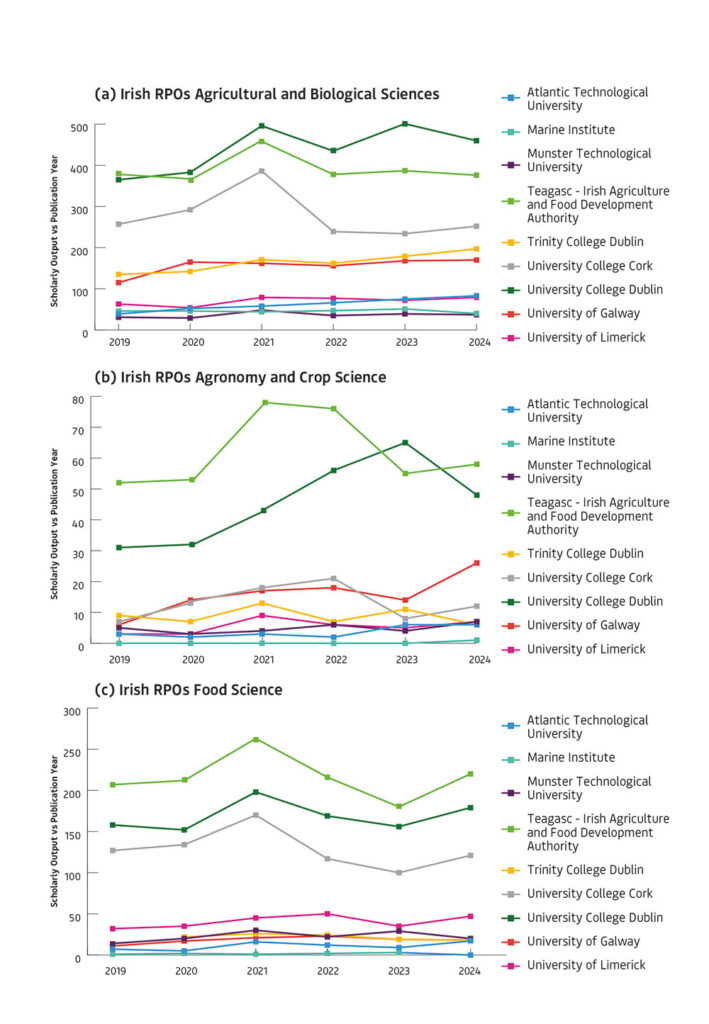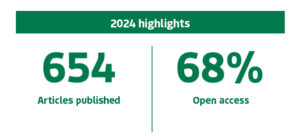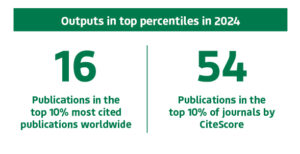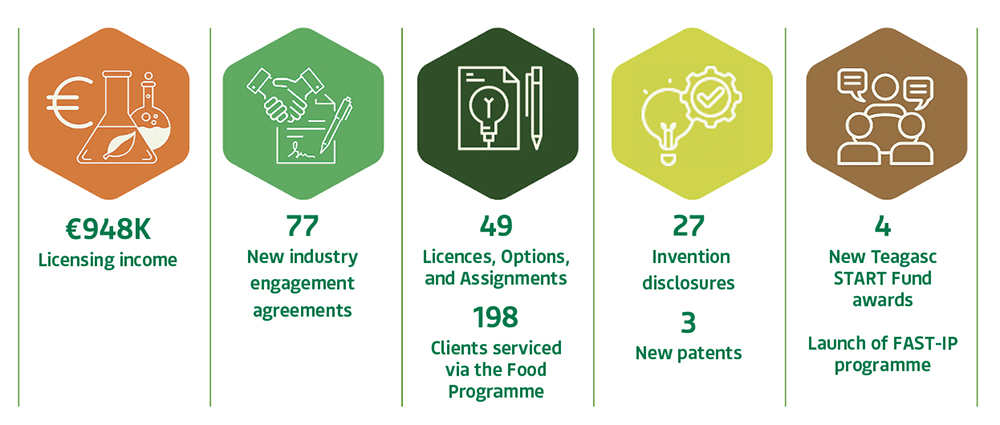Publications & innovation
Impact of Teagasc research publications
Emma Boughton, Teagasc Library and Information Services Officer
Teagasc uses two main approaches to identify the impact of its research: science excellence and societal impact. Science excellence focuses on peer-reviewed publications and their indicators of quality, while societal impact focuses on understanding the pathways through which such science is put into use and the changes it helps to bring about in society. Throughout this publication, we have focused on the impact pathways for each of the featured research impacts. In this article, we delve deeper into Teagasc’s peer-reviewed publications.

Peer-reviewed publications
Measuring the impact of research is a key activity for Teagasc. Here we consider one of the main indicators of science excellence – the performance of Teagasc articles in peer-reviewed journals – and compare it both to previous years and to the outputs of other relevant universities and Research Performing Organisations (RPOs). The inclusion criteria for this analysis are peer-reviewed articles published in the period 2019 to 2024, and having at least one Teagasc author.
Bibliometric analysis, which is based on citation counts, is one way to evaluate published research outputs. Citation counts and metrics from the Scopus database and the related SciVal research analytics tool were used in this analysis.
How Teagasc compares
Comparing Teagasc with Irish universities and other RPOs for this period, Teagasc published the second highest number of articles and had the second highest overall citation count in the SciVal broad category of ‘Agricultural & Biological Sciences’. For the narrower categories of ‘Food Science’ and ‘Agronomy and Crop Science’, Teagasc had the highest overall number of articles (see Figure 1).
Teagasc also performed well when compared to all European governmental organisations. For the category ‘Agricultural & Biological Sciences’, SciVal data places it 10th by total number of articles, and third by number of articles in the category of ‘Food Science’.
The strong international and national reputation of Teagasc research is demonstrated by the fact that in the years 2019 to 2024, 59% of the Teagasc peer-reviewed articles indexed by SciVal listed international collaborators, with a further 36% listing national collaborators.

2024 highlights 654 Articles published 68% Open access

Outputs in top percentiles in 2024 16 Publications in the top 10% most cited publications worldwide 54 Publications in the top 10% of journals by CiteScore
Impacts from technology development and adoption by industry

Compiled by Siobhán Jordan, Head of Technology Transfer and Commercialisation, Teagasc
Teagasc’s research and innovation activities in 2024 have contributed to the development of practical solutions for the agriculture and food sectors. By working closely with agri-food companies and industry partners, Teagasc supported the development and adoption of research, technologies, and knowledge that help to address productivity, sustainability and regulatory challenges across the sector.
For example, in 2024, Teagasc strengthened its role as a key innovation catalyst for Ireland’s food sector, delivering over €2M worth of high-impact technical and innovation services to 198 clients through the organisation’s Food Programme.
A significant share of these services was delivered across the meat, dairy, and prepared consumer foods sectors – cornerstones of Ireland’s agri-food economy.
Engage@Teagasc, the organisation’s dedicated Technology Transfer Office, continues to enable and support industry collaboration, entrepreneurship, and commercialisation. In 2024, the team supported 27 invention disclosures from across the Research programmes and filed three new patents. A total of 49 Licences, Options, and Assignments (LOAs) were signed, underlining the high level of commerci al interest in Teagasc technologies.
Profitable partnerships with companies through funding support from Enterprise Ireland, including Innovation Vouchers and Innovation Partnerships, are essential for collaboration and knowledge exchange.
Highlights also included the launch of the FAST-IP entrepreneurship programme with UCD, and the support of four new Teagasc START Fund awards to further develop high value commercial opportunities.
With the rollout of a revised Intellectual Property policy, 2024 has seen Teagasc strengthen its internal systems to support sustainable impact from research. These foundations ensure that future innovations are developed, protected, and translated to benefit Ireland’s farmers, food producers, and rural communities.

2024 activities and impacts delivered by Engage@Teagasc facilitating the delivery of end-user ready solutions
€948K Licensing income
77 New industry engagement agreements
49 Licences, Options, and Assignments
198 Clients serviced via the Food Programme
27 Invention disclosures
3 New patents
4 New Teagasc START Fund awards
Launch of FAST-IP programme
Shedding some light

The ContinuFOR site Fossy Hill underwent a light thinning to transform the Sitka spruce stands to continuous cover forestry (CCF). Thinning provides timber, while also increasing the growing space and light levels for the remaining trees. Another name for CCF is low impact management, and it is an alternative management option to clearfell forestry. Sites like Fossy Hill demonstrate alternatives to clearfell rotation forestry, and help with our research on the productivity and benefits of CCF systems.
Photo and description by:
Grace Jones
Teagasc Project:
ContinuFOR
Funding:
Department of Agriculture, Food and the Marine
